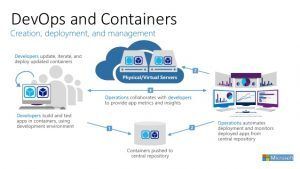The modern world is full of software releases built on microservices architecture, meaning using containers is suitable for better and safe output. Architecture is a crucial aspect in the making of software, but it is not the main aspect- the organization’s culture and methodologies play a significant role in the entire software production process.
DevOps practices make it easy for the production team to execute their roles properly to avoid irreversible on the software in the future. This is an indication containers, and DevOps complement each other. In this article, I’ll discuss how containers and DevOps relate and what containerization is all about in simple terms.
What Is Containerization?
Containerization is putting together all an application’s dependencies into a single package (container). The single package can run on any server or in the cloud because the containerization aspect allows your system or application to be portable and flexible.
Let’s dive into containers themselves and how they can benefit DevOps teams or engineers.
The Idea Behind Containers
It wasn’t easy to install and run any system or software on any server because of different requirements like a compatible operating system and libraries or tools that should be installed to run the software. Also, you need to get permission for directories and files by ticking different checkboxes to run your software successfully.
Despite meeting all these requirements, the problems don’t end. Even if you decide to run the application on a cloud environment, hoping it will protect the software from breaking, the results may remain the same. However, containers come in as the rescue for these problems.
Containers ensure the software runs properly without worrying about the libraries by isolating it from the cloud environment. Now, this concept may sound the same as using a virtual machine, but the difference is container virtualizes the operating system, whereas a VM is an entity of physical hardware.
You can run containers in any operating system, including Linux and Windows, to achieve the isolation and portability aspects. On the Linux system, cgroupsand namespace are used to achieve the isolation, whereas Windows job objects and Server Silos are used to build the containers. These features can help you run your application without conflicts within the operating system or with other containers.
So, how do these containers work? Cgroups limit the hardware resources in a given process. This means you can limit CPU or RAM for one specific process. In contrast, Namespaces allow the isolation of scope for a process. These isolation processes can be tedious, and that’s where container runtime tools such as Docker and podman come in. However, they work differently, but the end goal is the same. They manage the namespace and cgroups for you; that’s why you could hear a DevOps engineer saying, “I want a container that can hold this amount of libraries.”
Benefits of Containers
Do not stress yourself with all the conceptualization of containers. Just understand how the tools of container runtimes functions or their benefits, such as Docker. These containers have many benefits in different environments, including development, testing, and production. They include;
• Flexibility
• Addresses security concerns
• Continuous Deployments
• Efficient scheduling rules
• Eases troubleshooting processes
Conclusion
It is necessary to understand all aspects of containers to improve or be aware of monitoring environments to eliminate any obstacle that may cause downtime in your application. I hope this article has covered what you need to know about containerization.



Top comments (2)
Thank you for writing this.
welcome